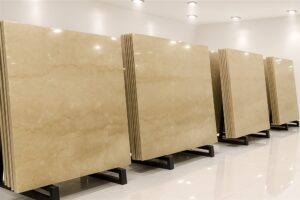Marble countertops are a dream choice for many homeowners seeking elegance, sophistication, and natural beauty in their kitchens. But not all marbles are created equal—some types are more suited for kitchen use due to their durability, appearance, and maintenance needs.
In this blog, we’ll explore the top marble varieties for kitchens, breaking down their features, pros and cons, ideal applications, and care tips to help you make the best choice for your culinary space.
What Makes a Marble Kitchen-Friendly?
Before choosing a marble type, consider the following factors:
- Durability: Resistance to heat, scratching, and everyday wear.
- Porosity: Some marbles stain more easily unless properly sealed.
- Aesthetic Appeal: Veining, color, and how it pairs with cabinets or flooring.
- Maintenance: Frequency of sealing and ease of cleaning.
- Budget & Availability: Exotic marbles may offer beauty at a premium.
Top Marble Types for Kitchens
1. Carrara Marble
- Origin: Italy
- Appearance: Soft white or light gray background with delicate, feathery veining.
- Why It Works: Timeless, classic, and relatively affordable. Works well with both modern and traditional kitchen styles.
- Pros: Versatile, elegant, and budget-friendly.
- Cons: Porous and prone to etching—requires regular sealing.
- Best For: All-white kitchens, minimalist interiors, or budget-conscious luxury.
2. Calacatta Marble
- Origin: Italy
- Appearance: Bright white with bold gold or grey veining—dramatic and luxurious.
- Why It Works: A statement-making marble is often used for kitchen islands or feature counters.
- Pros: High-end aesthetic and unique veining.
- Cons: Expensive and requires careful maintenance.
- Best For: Upscale kitchens, open-plan show kitchens, or waterfall designs.
3. Statuario Marble
- Origin: Italy
- Appearance: Pure white with dramatic grey or gold veins; ultra-refined and rare.
- Why It Works: One of the most premium marbles, ideal for contemporary luxury kitchens.
- Pros: Dramatic, elegant, and distinctive.
- Cons: High cost, more sensitive to etching and staining.
- Best For: Modern, minimalist homes with curated interiors.
4. Nero Marquina Marble
- Origin: Spain
- Appearance: Deep black with stark white veining—bold and modern.
- Why It Works: Adds contrast, drama, and depth to kitchen spaces while being more forgiving of stains.
- Pros: Striking visual impact, stains are less visible.
- Cons: Scratches can stand out on dark surfaces; Needs sealing.
- Best For: Black-and-white themes, modern kitchens, and accent countertops.
5. Crema Marfil Marble
- Origin: Spain
- Appearance: Warm beige to golden tones with soft veining.
- Why It Works: Blends well with wood, rustic, and Mediterranean kitchens.
- Pros: Cozy, neutral tone that complements various cabinetry.
- Cons: Slightly softer and more porous than other marbles.
- Best For: Traditional or earth-toned kitchen interiors.
6. Makrana & Exotic Regional Marbles
- Makrana Marble (India): A brilliant white, fine-grained marble known for durability and low water absorption. Famously used in the Taj Mahal.
- Other Exotic Varieties:
- Rainforest Marble: Bold green or brown veining with a forest-like texture.
- Rojo Alicante: Rich red marble with subtle white veins.
- Thassos Marble: Ultra-pure white marble from Greece.
- Pros: Unique aesthetics, cultural richness, and design flexibility.
- Cons: Rarer, more expensive, and still require sealing.
- Best For: Heritage-rich homes, cultural interiors, or homeowners looking for one-of-a-kind slabs.
Marble Maintenance Tips for Kitchens
Even the best marble needs thoughtful care to preserve its beauty in a kitchen environment:
- Seal countertops at least once a year (or as recommended by your fabricator).
- Clean spills immediately, especially acidic ones like lemon juice, vinegar, or wine.
- Use cutting boards and heat mats to protect surfaces from scratches or heat damage.
- Choose a honed finish to reduce the visibility of etching and fingerprints.
- Always use pH-neutral cleaners—avoid bleach or acidic agents.
Quick Comparison Chart
| Marble Type | Look & Usage | Pros | Cons | Best In… |
|---|---|---|---|---|
| Carrara | Classic white elegance | Affordable, versatile | Needs regular sealing | All-white, rustic, or classic kitchens |
| Calacatta | Bold luxury | Showstopper look | Expensive, porous | Islands, statement pieces |
| Statuario | Clean, refined drama | Elegant and rare | High maintenance | High-end, minimal kitchens |
| Nero Marquina | High-contrast, modern | Stain-hiding aesthetics | Scratches visible | Bold, contemporary spaces |
| Crema Marfil | Warm and neutral | Cozy and classic | Softer than others | Traditional, wood-tone kitchens |
| Makrana | Pure white, historic appeal | Low porosity, durable | Regional availability | Heritage homes, Indian interiors |
Final Recommendations
- For affordable luxury: Go with Carrara Marble—timeless and cost-effective.
- For luxury design and dramatic veining: Opt for Calacatta or Statuario.
- For bold contrast and stain-friendly surface: Choose Nero Marquina.
- For a warm, cozy palette: Crema Marfil fits beautifully with wood cabinetry.
- For heritage and lasting durability: Makrana is a top-tier choice.
Final Thoughts
Marble can transform any kitchen into a space of timeless luxury and natural beauty. While it requires care and maintenance, the visual payoff is immense. From the soft elegance of Carrara to the bold personality of Nero Marquina or the rich legacy of Makrana, there’s a marble type that’s just right for your kitchen.Need help choosing the right marble slab for your home? Reach out to us personalized advice, samples, and competitive pricing.





